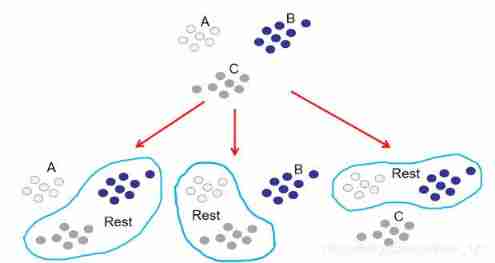当前位置:网站首页>[combinatorics] combinatorial identities (review of eight combinatorial identities | product of combinatorial identities 1 | proof | use scenario | general method for finding combinatorial numbers)
[combinatorics] combinatorial identities (review of eight combinatorial identities | product of combinatorial identities 1 | proof | use scenario | general method for finding combinatorial numbers)
2022-07-03 16:01:00 【Programmer community】
List of articles
- One 、 Review of combinatorial identities ( 8 individual )
- Two 、 Combinatorial identity ( product )
- 3、 ... and 、 Combinatorial identity ( product ) prove
- Four 、 Combinatorial identity ( product ) purpose 、 A general method for finding combinatorial numbers
Combinatorial identity reference blog :
- 【 Combinatorial mathematics 】 Combinatorial identity ( Recurrence Combinatorial identity | Change the next term to sum Combinatorial identity Simple and | Change the next term to sum Combinatorial identity Staggered and )
- 【 Combinatorial mathematics 】 Combinatorial identity ( Change the next term to sum 3 Combinatorial identity | Change the next term to sum 4 Combinatorial identity | binomial theorem + Derivation Prove the combinatorial identity | Use known combinatorial identities to prove combinatorial identities )
One 、 Review of combinatorial identities ( 8 individual )
1 . Combinatorial identity ( recursion ) :
( 1 ) recursion 1 :
(
n
k
)
=
(
n
n
−
k
)
\dbinom{n}{k} = \dbinom{n}{n-k}
(kn)=(n−kn)
( 2 ) recursion 2 :
(
n
k
)
=
n
k
(
n
−
1
k
−
1
)
\dbinom{n}{k} = \dfrac{n}{k} \dbinom{n - 1}{k - 1}
(kn)=kn(k−1n−1)
( 3 ) recursion 3 ( Pascal / Yang Hui's trigonometric formula ) :
(
n
k
)
=
(
n
−
1
k
)
+
(
n
−
1
k
−
1
)
\dbinom{n}{k} = \dbinom{n - 1}{k} + \dbinom{n - 1}{k - 1}
(kn)=(kn−1)+(k−1n−1)
2 . Review the combinatorial identities of summation under four variables : The combinatorial identity introduced earlier The number of combinations in
(
n
k
)
\dbinom{n}{k}
(kn) , Is the next item
k
k
k Have been accumulating changes , have
∑
k
=
0
n
\sum\limits_{k=0}^{n}
k=0∑n Cumulative property , Previous item
n
n
n It is the same. ;
( 1 ) Simple and :
∑
k
=
0
n
(
n
k
)
=
2
n
\sum\limits_{k=0}^{n}\dbinom{n}{k} = 2^n
k=0∑n(kn)=2n
( 2 ) Staggered and :
∑
k
=
0
n
(
−
1
)
k
(
n
k
)
=
0
\sum\limits_{k=0}^{n} (-1)^k \dbinom{n}{k} = 0
k=0∑n(−1)k(kn)=0
( 3 ) Change the next term to sum 3 :
∑
k
=
0
n
k
(
n
k
)
=
n
2
n
−
1
\sum\limits_{k=0}^{n} k \dbinom{n}{k} = n 2^{n-1}
k=0∑nk(kn)=n2n−1
( 4 ) Change the next term to sum 4 :
∑
k
=
0
n
k
2
(
n
k
)
=
n
(
n
+
1
)
2
n
−
2
\sum_{k=0}^{n} k^2 \dbinom{n}{k} = n ( n+1 ) 2^{n-2}
∑k=0nk2(kn)=n(n+1)2n−2
3 . Change the upper term to sum :
∑
l
=
0
n
(
l
k
)
=
(
n
+
1
k
+
1
)
\sum\limits_{l=0}^{n} \dbinom{l}{k} = \dbinom{n + 1}{k + 1}
l=0∑n(kl)=(k+1n+1)
Two 、 Combinatorial identity ( product )
Combinatorial identity ( product ) :
(
n
r
)
(
r
k
)
=
(
n
k
)
(
n
−
k
r
−
k
)
\dbinom{n}{r}\dbinom{r}{k} = \dbinom{n }{k}\dbinom{n-k}{r-k}
(rn)(kr)=(kn)(r−kn−k)
3、 ... and 、 Combinatorial identity ( product ) prove
1 .
(
n
r
)
(
r
k
)
\dbinom{n}{r}\dbinom{r}{k}
(rn)(kr) Combinatorial number analysis : This is the multiplication of two combinatorial numbers , It uses Step by step counting principle , Corresponding multiplication rule ;
( 1 ) First step :
(
n
r
)
\dbinom{n}{r}
(rn) from
n
n
n Of the elements
r
r
r Elements ;
( 2 ) The second step :
(
r
k
)
\dbinom{r}{k}
(kr) from
r
r
r Of the elements
k
k
k Elements ;
2 . The above choices may be repeated , The following counterexample can prove :
aggregate
S
=
{
a
,
b
,
c
,
d
,
e
}
S = \{ a, b, c, d, e \}
S={ a,b,c,d,e} , From this set
S
S
S Choose from
4
4
4 Elements , Two chestnuts :
①
{
a
,
b
,
c
,
d
}
\{a, b, c, d\}
{ a,b,c,d} , There are subsets
{
b
,
c
,
d
}
\{ b,c,d \}
{ b,c,d}
②
{
b
,
c
,
d
,
e
}
\{ b,c,d,e \}
{ b,c,d,e} , There are subsets
{
b
,
c
,
d
}
\{ b,c,d \}
{ b,c,d}
So from
5
5
5 Of the elements
4
4
4 individual , And then from
4
4
4 Of the elements
3
3
3 individual , Last There is a case of selecting duplicate subsets , There are two repetitions
{
b
,
c
,
d
}
\{ b,c,d \}
{ b,c,d} ;
3 .
(
n
k
)
(
n
−
k
r
−
k
)
\dbinom{n }{k}\dbinom{n-k}{r-k}
(kn)(r−kn−k) Combinatorial number analysis :
(
n
k
)
\dbinom{n }{k}
(kn) Express from
n
n
n Of the elements , Directly select
k
k
k Elements come out , See how many methods there are ; chestnuts : Above
5
5
5 Direct selection in meta set
3
3
3 Number of element subsets ;
(
n
−
k
r
−
k
)
\dbinom{n-k}{r-k}
(r−kn−k) yes The repeatability of the above selection method , How many times does each selection method appear ; chestnuts : Calculate each of the above
3
3
3 The number of repetitions of the element subset selection scheme ;
4 . Now let's start to study the above
(
n
−
k
r
−
k
)
\dbinom{n-k}{r-k}
(r−kn−k) How is the repeatability calculated
Take the chestnuts above for example ,
3
3
3 A subset of
{
b
,
c
,
d
}
\{ b,c,d \}
{ b,c,d} The reason why it happened twice is ,
stay
4
4
4 A subset of
{
a
,
b
,
c
,
d
}
\{a, b, c, d\}
{ a,b,c,d} and
{
b
,
c
,
d
,
e
}
\{ b,c,d,e \}
{ b,c,d,e} All contain the same
3
3
3 A subset of
{
b
,
c
,
d
}
\{ b,c,d \}
{ b,c,d} ,
In the above
4
4
4 Subsets , except
3
3
3 Outside the subset , There are other added elements ,
- stay
{
a
,
b
,
c
,
d
}
\{a, b, c, d\}
{ a,b,c,d} in , Added
a
a
a Elements
- stay
{
b
,
c
,
d
,
e
}
\{b,c,d,e\}
{ b,c,d,e} in , Added
e
e
e Elements
stay
3
3
3 Subsets , Add different elements , It can become Different
4
4
4 A subset of , Here we directly ask for
3
3
3 How many ways to add subsets , constitute
4
4
4 Number of subsets ;
The added element is from The original
S
=
{
a
,
b
,
c
,
d
,
e
}
S = \{ a, b, c, d, e \}
S={ a,b,c,d,e} Collection , Get rid of
{
b
,
c
,
d
}
\{ b,c,d \}
{ b,c,d}
3
3
3 Selected from the elements after the subset ,
The selected set has
5
−
3
=
2
5-3 = 2
5−3=2 Elements ( It's equivalent to a formula
n
−
k
n-k
n−k ) ,
The number selected is
4
−
3
=
1
4-3=1
4−3=1 individual ( It's equivalent to a formula
r
−
k
r-k
r−k ) ;
from
n
−
k
n-k
n−k Of the elements
r
−
k
r-k
r−k Elements , The number of programmes is
(
n
−
k
r
−
k
)
\dbinom{n-k}{r-k}
(r−kn−k) ;
5 .
(
n
r
)
(
r
k
)
=
(
n
k
)
(
n
−
k
r
−
k
)
\dbinom{n}{r}\dbinom{r}{k} = \dbinom{n }{k}\dbinom{n-k}{r-k}
(rn)(kr)=(kn)(r−kn−k) The left and right sides of are the counting results of the same combined number , So it's equal
Four 、 Combinatorial identity ( product ) purpose 、 A general method for finding combinatorial numbers
Combinatorial identity ( product ) :
(
n
r
)
(
r
k
)
=
(
n
k
)
(
n
−
k
r
−
k
)
\dbinom{n}{r}\dbinom{r}{k} = \dbinom{n }{k}\dbinom{n-k}{r-k}
(rn)(kr)=(kn)(r−kn−k)
encounter
(
n
r
)
(
r
k
)
\dbinom{n}{r}\dbinom{r}{k}
(rn)(kr) Product first , The case of re summation , If the sum is right
r
r
r Words of peace , namely
∑
r
=
0
n
\sum\limits_{r=0}^{n}
r=0∑n , as follows :
Yes
∑
r
=
k
n
(
n
r
)
(
r
k
)
\sum\limits_{r=k}^{n}\dbinom{n}{r}\dbinom{r}{k}
r=k∑n(rn)(kr) Sum up ;
Yes
r
r
r Sum up ,
r
r
r It's from
k
k
k Until
n
n
n ,
Previous items
(
n
r
)
\dbinom{n}{r}
(rn) Next is the variable ,
The following items
(
r
k
)
\dbinom{r}{k}
(kr) The last item is a variable ,
The previous general method : This makes it impossible to use the previous calculation method , The previous calculation method is , Constant to
∑
\sum
∑ Extract outside the symbol , The rest turns into Basic summation
∑
k
=
0
n
(
n
k
)
=
2
n
\sum\limits_{k=0}^{n}\dbinom{n}{k} = 2^n
k=0∑n(kn)=2n , Or known Combinatorial identity , Combination formula , To simplify ;
How to deal with the situation : Two combinatorial numbers , One is that the next item is the cumulative variable , One is that the previous term is an additive variable , Multiply two combinatorial numbers The situation of ;
Above The product combination identity can change the above situation into Next Is the case of cumulative variables ;
Use the above Product combinatorial identity , Turn into :
∑
r
=
k
n
(
n
r
)
(
r
k
)
=
∑
r
=
k
n
(
n
k
)
(
n
−
k
r
−
k
)
\sum\limits_{r=k}^{n}\dbinom{n}{r}\dbinom{r}{k} = \sum\limits_{r=k}^{n} \dbinom{n }{k}\dbinom{n-k}{r-k}
r=k∑n(rn)(kr)=r=k∑n(kn)(r−kn−k)
After obtaining the above formula , Items obtained by analysis
∑
r
=
k
n
(
n
k
)
(
n
−
k
r
−
k
)
\sum\limits_{r=k}^{n} \dbinom{n }{k}\dbinom{n-k}{r-k}
r=k∑n(kn)(r−kn−k) ,
Ahead
(
n
k
)
\dbinom{n }{k}
(kn) Item and Summation variables
r
r
r irrelevant ,
hinder
(
n
−
k
r
−
k
)
\dbinom{n-k}{r-k}
(r−kn−k) The next item is related to Summation variables
r
r
r relevant ;
therefore
(
n
k
)
\dbinom{n }{k}
(kn) term You can extract
∑
\sum
∑ Outside the symbol ;
=
(
n
k
)
∑
r
=
k
n
(
n
−
k
r
−
k
)
=\dbinom{n }{k} \sum\limits_{r=k}^{n} \dbinom{n-k}{r-k}
=(kn)r=k∑n(r−kn−k)
The above formula can be used Variable limit , Substitution calculation ; Use
r
′
=
r
−
k
r' = r-k
r′=r−k Replace
r
r
r ;
original
r
r
r The range of phi is zero
k
k
k ~
n
n
n , be
r
′
=
r
−
k
r' = r-k
r′=r−k The range of phi is zero
0
0
0 ~
n
−
k
n-k
n−k , The substitution result is as follows :
=
(
n
k
)
∑
r
′
=
0
n
−
k
(
n
−
k
r
′
)
=\dbinom{n }{k} \sum\limits_{r'=0}^{n - k} \dbinom{n-k}{r'}
=(kn)r′=0∑n−k(r′n−k)
according to Basic summation
∑
k
=
0
n
(
n
k
)
=
2
n
\sum\limits_{k=0}^{n}\dbinom{n}{k} = 2^n
k=0∑n(kn)=2n , Calculation
∑
r
′
=
0
n
−
k
(
n
−
k
r
′
)
\sum\limits_{r'=0}^{n - k} \dbinom{n-k}{r'}
r′=0∑n−k(r′n−k) As the result of the
2
n
−
k
2^{n-k}
2n−k ; The final calculation result is :
=
(
n
k
)
∑
r
′
=
0
n
−
k
(
n
−
k
r
′
)
=
2
n
−
k
(
n
k
)
=\dbinom{n }{k} \sum\limits_{r'=0}^{n - k} \dbinom{n-k}{r'} = 2 ^{n-k}\dbinom{n }{k}
=(kn)r′=0∑n−k(r′n−k)=2n−k(kn)
边栏推荐
- 找映射关系
- How to use AAB to APK and APK to AAB of Google play apps on the shelves
- [redis foundation] understand redis persistence mechanism together (rdb+aof graphic explanation)
- Go语言自学系列 | golang中的if else语句
- 近视:摘镜or配镜?这些问题必须先了解清楚
- Approval process design
- Effect of ARP package on FTP dump under vxworks-6.6 system
- How idea starts run dashboard
- [list to map] collectors Tomap syntax sharing (case practice)
- QT use qzxing to generate QR code
猜你喜欢

【OpenCV 例程200篇】217. 鼠标交互获取多边形区域(ROI)

2022年Q2加密市场投融资报告:GameFi成为投资关键词

Popular understanding of ovo and ovr

How are integer and floating-point types stored in memory

“用Android复刻Apple产品UI”(2)——丝滑的AppStore卡片转场动画

Microservices - load balancing ribbon

Shell script import and export data

Subclass hides the function with the same name of the parent class

App移动端测试【5】文件的写入、读取

关于网页中的文本选择以及统计选中文本长度
随机推荐
Location of software installation information and system services in the registry
Redis高可用与持久化
The accept attribute of the El upload upload component restricts the file type (detailed explanation of the case)
CString的GetBuffer和ReleaseBuffer使用说明
First!! Is lancet hungry? Official documents
[redis foundation] understand redis persistence mechanism together (rdb+aof graphic explanation)
Pychart error updating package list: connect timed out
CString getbuffer and releasebuffer instructions
[proteus simulation] 74hc595+74ls154 drive display 16x16 dot matrix
深度学习之三维重建
Redis high availability and persistence
Backtracking method to solve batch job scheduling problem
The difference between calling by value and simulating calling by reference
[系统安全] 四十三.Powershell恶意代码检测系列 (5)抽象语法树自动提取万字详解
Detailed pointer advanced 1
远程文件包含实操
Popular understanding of ovo and ovr
请求头不同国家和语言的表示
How to use AAB to APK and APK to AAB of Google play apps on the shelves
六月 致 -.-- -..- -